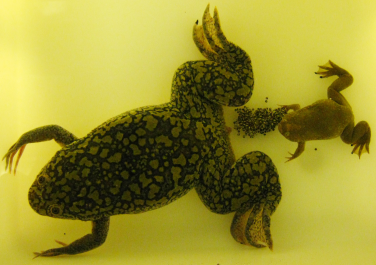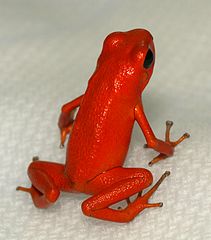Many of the world’s nearly 6,000 frog species make wonderful pets that may live for 10, 20 or even 50 years. Among them we find creatures that glide, brood their eggs in vocal sacs, form lifelong pair bonds and exhibit other fascinating behaviors. While the smallest is barely as large as a pea, the nine-pound African Bullfrog can chase lions away from its tadpoles! Today I’d like to introduce some of my favorites, each of which is hardy enough for beginners yet so interesting that herpetologists – myself included – regularly keep them as pets. Please be sure to let me know about your own “best pet frogs” by posting below.
Frog Care
Even the toughest of frogs have specific care needs that must be met if they are to thrive. The following information is meant to illustrate why one should consider a particular type of frog. It is not a complete care guide…please be sure to post below for detailed information about keeping and breeding these or other frogs.
African Clawed Frog, Xenopus laevis
I’ve worked with hundreds of frog species, but this one remains my favorite both in and out of captivity. One individual in my collection is approximately 26 years old, and others have lived even longer.
The aquatic African Clawed Frog is unusual in that it will accept dry commercial food – a real plus for those who do not wish to handle the live insects that most demand. Reptomin, freeze-dried shrimp and an occasional bit of leftover fish will meet this hardy fellow’s needs. Live food will, however, initiate enthusiastic and often comical reactions, and may help to spur breeding. Small minnows, earthworms, crickets and similar foods are all relished.
Clawed Frogs are possibly the most responsive and active of amphibian pets. They quickly learn to swim to the surface when one approaches, and will eagerly feed from the hand. A simple filtered aquarium kept at room temperature is all they demand in the way of accommodations.
White’s or Dumpy Treefrog, Litoria caerulea
This terrestrial frog is a favorite pet worldwide, and with good reason. Charmingly plump and clownish in its movements, the White’s Treefrog is completely at ease around people. It is always ready to clamber up on one’s arm for a snack, and can easily be trained to accept canned insects. Although a stout build and 4-5 inch length renders it among the largest of all treefrogs, this Australian native does well in relatively small quarters.
Pet White’s Treefrogs have reached nearly 25 years of age, and require supplemental heat only during the winter in temperate regions.
Dwarf African Clawed Frog, Hymenochirus boettgeri or H. curtipes
In common with its larger relative, the African Clawed Frog, this tiny frog is aquatic and tongue-less (food is stuffed into the mouth with the highly mobile fingers). They are very engaging – getting along well in groups, perpetually probing about for food and even breeding if conditions are right. With a body shape and swimming style that brings to mind a tiny human diver, these frogs are a real delight to observe.
Ideal for frog enthusiasts with limited space, Dwarf Clawed Frogs barely reach 2 inches in length. A small betta bowl can comfortably house a pair, while a 5 gallon aquarium will support 4-6. Although some individuals will accept freeze dried foods, Dwarf Clawed Frogs require live blackworms, brine shrimp and other invertebrates if they are to remain in peak condition. A small aquarium heater should be used to maintain a temperature of 75-78 F.
A Word About Toads
American Toads, Marine Toads and related species are usually very calm in demeanor and adjust exceedingly well to captivity. Toad-keepers invariably use words such as “laid-back” and “trusting” to describe their pets. Unfortunately, amphibian keepers have paid very little interest to toads, and captive-bred specimens are rarely available.
One possible exception is the Marine or Cane Toad, Chaunus (Bufo) marinus. Occasionally bred in captivity, Marine Toads make very responsive pets, but they get quite large and need spacious accommodations. Please post below for further information.
Many other species could have been included in this article…please be sure to post your own suggestions below.
 That Reptile Blog – Reptile, Amphibian and Exotic Pet Care and Information
That Reptile Blog – Reptile, Amphibian and Exotic Pet Care and Information






I like frogs
I LIKE FROGS! i have to do a report on frogs and i
like this website.
Thank you for the kind words. Please let me know if you have any questions or need information. Good luck, Frank